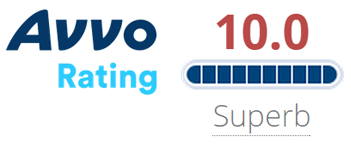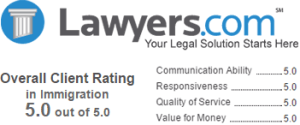Shusterman’s Immigration Update October 2013
Volume Eighteen, Number Ten
 SHUSTERMAN’S IMMIGRATION UPDATE is the Web’s most popular e-mail newsletter regarding U.S. immigration laws and procedures with over 40,000 subscribers located in more than 150 countries. It is written by a former INS Trial Attorney (1976-82) with over 35 years of experience practicing immigration law.
SHUSTERMAN’S IMMIGRATION UPDATE is the Web’s most popular e-mail newsletter regarding U.S. immigration laws and procedures with over 40,000 subscribers located in more than 150 countries. It is written by a former INS Trial Attorney (1976-82) with over 35 years of experience practicing immigration law.
Published by the Law Offices of Carl Shusterman, 600 Wilshire Blvd, Suite 1550, Los Angeles, California, 90017. Phone: (213) 623-4592 x 0.
Subscribe to our E-Mail Newsletter, join the conversation on our Immigration Facebook Page, follow our Blog Posts and subscribe to our “How-To” Immigration Videos.
Client Reviews

They Are About Providing Solutions
“I am an Internationally Educated Nurse petitioned by US employer and the Law Offices of Carl Shusterman helped me throughout the entire process of my IV application. They were extremely thorough with regard to the instructions and the steps that I needed.”
- Francis R., Nashville, Tennessee
Read More Reviews
Zoom Consultations Available!
Newsletter US Immigration Update October 2013
TABLE OF CONTENTS:
1. House CIR Bill May Be Introduced in Early October
2. Driver’s Licenses for the Undocumented in California
3. Shusterman’s Upcoming Immigration Law Seminars
4. Green Card Lottery Begins on October 1
5. Success Story: Green Card Through Hardship
6. Immigration Trivia Quiz: Statues Dedicated to Immigrants
7. State Department Visa Bulletin for October 2013
8. Immigration Government Processing Times
9. Ask Mr. Shusterman: New Spanish Immigration Videos
10. Winner of Our September 2013 Trivia Quiz!
NEWS FLASHES:
- DOJ Files Opening Brief in CSPA Class Action Lawsuit – The Department of Justice filed its opening brief in DeOsorio v. Mayorkas, the nationwide CSPA class action lawsuit on September 3. Our brief is due on October 28. We will be flying out to D.C. for the Oral Argument before the Supreme Court of the United States which will take place on December 10.
- DOS Updates Contact Info – The Department of State (DOS) has updated its How to Contact Us page with phone numbers for the Public Inquiries Division and the Business Visa Center. The page also has updated contact information for the National Visa Center and the Kentucky Consular Center.
- EOIR Headquarters’ New Zip Code – As of October 1, the EOIR headquarters will be processing their mail through a new facility. While the street address will stay the same, the zip code will change from 22031 to 20530.
- Immigration Attorney Wins Award for MAVNI Program – Immigration Attorney Margaret Stock has been awarded a MacArthur Foundation “Genius” grant for her work in establishing the MAVNI program and on the AILA Military Assistance Program. The MAVNI program is considered highly innovative in its ability to recruit skilled talent into the US armed services by providing qualified individuals a pathway to citizenship when they serve in positions vital to the national interest.
- Immigration “How-To” Videos – Our 45+ “How-To” Immigration Videos has been viewed over 500,000 times. Subjects include the comprehensive immigration reform (CIR) bill, how to obtain a green card, become a U.S. citizen, win your case in immigration court and how to select an immigration attorney. Our video Green Cards through Marriage has been viewed over 175,000 times. We encourage you to take advantage of this free resource.
- U.S. Labor Secretary Vows to Push for Immigration Reform – In his first major speech, the new U.S. Department of Labor Secretary, Thomas Perez, vowed to work with President Barack Obama on passing comprehensive immigration reform, raising the minimum wage and implementing the new healthcare law.
- Texas Non-Profit Closed Due to Unauthorized Immigration Services – Cristo Vive, a non-profit organization in Austin, Texas, was shut down after it was found to be providing unauthorized legal services to immigrants. The organization has been ordered to pay more than $500,000 in fines and restitution.
1. House CIR Bill May Be Introduced in Early October
With a possible government shutdown and the looming fight over the debt ceiling on the horizon, you may be under the impression that immigration reform has been placed on the back burner. If so, you would be sorely mistaken.
The two political parties are very aware that the growing Latino/Asian vote cannot be ignored. Besides, business, labor and various religious groups are also pushing for immigration reform.
Thus it should come as no surprise that House Minority Leader Nancy Pelosi (D-CA) together with a number of her colleagues may introduce a Comprehensive Immigration Reform bill in the House of Representatives early in October.
The Pelosi bill would combine the benefits portions of the CIR bill (S. 744) already passed by the Senate with a border protection bill passed by the House Homeland Security Subcommittee. Committee members voted unanimously for Chairman Mike McCaul’s (R-TX) bill to secure the border without doubling the size of the Border Patrol. McCaul’s bill would direct the DHS to develop a plan which would result in the apprehension of 90% of illegal border crossers within five years.
This may be a good strategy as not all GOP Senators and very few budget-conscious House Republicans favor the $20 billion border security provisions of S.744. Senator John McCain (R-AZ) put it bluntly when he stated that “we don’t need 20,000 additional Border Patrol agents.”
The main impetus for Pelosi and her colleagues is their perception that the GOP may not plan to put forth a bill which contains a Pathway to Citizenship for the 11 million undocumented persons present in the U.S. This view gained additional adherents when, in September, two more Republican House Members left the “Gang of Eight” House members who have been working on immigration reform legislation for some time. Representative Raul Labrador (R-ID) left the group some time ago.
Despite this, influential House Judiciary Chairman Bob Goodlatte (R-VA) stated during a forum on Hispanic Heritage Month that he wants the House to vote on immigration legislation “the sooner the better”. Conspicuously absent from the bills which have passed his committee are any which include a Pathway to Citizenship. However, Chairman Goodlatte recently had a very cordial meeting with pro-CIR Representatives Luis Gutierrez (D-IL) and Henry Cuellar (D-TX). He seems to be on the verge of introducing a bill which would legalize the 11 million, but only provide a Pathway to Citizenship to undocumented persons who came to the United States as children. This approach is far from perfect as it would leave adults in a state of perpetual limbo. On the other hand, it could lead to a compromise bill between the Senate and the House.
The clock is ticking. The GOP needs to introduce a CIR bill very soon, or the Democrats will take the lead on immigration reform in the House.
2. Driver’s Licenses for the Undocumented in California
On September 13, the California State Legislature passed a bill which would enable undocumented immigrants to apply for California State Drivers Licenses beginning in 2015. The State Senate passed the bill, AB60, by a 28-8 vote while the Assembly’s vote was 55-19. Governor Jerry Brown has indicated that he will sign the bill into law.
The drivers licenses issued to the undocumented would allow them to drive legally, but not to apply for other benefits. There will be a notation on the license stating that the document “does not establish eligibility for employment or for public benefit”. The licenses will contain the initials “DP” (Drivers Privilege) instead of “DL” (Drivers License).
Like other applicants, the undocumented will have to pass both a written and a driving test, and comply with applicable rules issued by the Department of Motor Vehicles. These drivers would then be eligible to purchase automobile insurance.
“These licenses will include a special watermark on the front and language on the back that makes it clear this license is for driving only and not identification,” said Kim Raney, who is the President of the California Police Chiefs Association. “TSA and federal officials and law enforcement will all be aware that these grant driving privileges only and aren’t confirmed identification.”
Nine other states have enacted laws allowing undocumented immigrants to apply for state drivers licenses, six this year. Prior to 1993, a person’s immigration status was not a criterion for obtaining a California Drivers License. Approximately 2.6 million undocumented persons reside in California.
Although some persons criticized this measure as a “quasi-amnesty”, it was strongly endorsed by the California Police Chiefs Association, the insurance industry and Los Angeles Police Chief Charlie Beck. The police chiefs believe that the measure will increase traffic safety and diminish the number of hit and run accidents.
A statement issued by Governor Brown stated that “This bill will enable millions of people to get to work safely and legally…Hopefully, it will send a message to Washington that immigration reform is long past due.”
3. Shusterman’s Upcoming Immigration Law Seminars
- AILA Colorado
2nd Annual Rocky Mountain Immigration Law Fall Conference
Ameristar Resort and Casino
Blackhawk, Colorado
October 17-18, 2013
Topic: “Understanding the Child Status Protection Act”
- University of Texas Law School
2013 Conference on Immigration and Nationality Law
AT&T Conference Center
Austin, Texas
October 25, 2013
Topic 1: “Hot Topics in Immigration Reform and Family Immigration Law”
Topic 2: “Ask the Experts”
- AMN Healthcare Healthcare Workforce Summit
Gaylord Texan
Grapevine, Texas
November 7-8, 2013
Topic: “International Clinicians and Physicians”
- Pincus Professional Education
Continuing Legal Education (CLE)
Los Angeles Athletic Club
Los Angeles, California
November 14, 2013
Topic: “Immigration 101”
4. Green Card Lottery Begins on October 1
Registration
The Diversity Visa Lottery program for FY 2015 will open for registration beginning on October 1 at noon (EDT) and close at noon (EDT) on November 2.
To register, you must submit an online form and digital photo to the DV lottery website. Only one application is allowed per person.
Every fiscal year (FY), up to 50,000 green cards are given out through the Green Card Lottery program . This program is geared toward bringing “diversity immigrants” from countries with low levels of immigration to the United States.
In order to apply, a foreign national must have either: 1) a high school education or its equivalent or 2) two years of work experience within the past five years in a field requiring at least two years of training.
Winners
Lottery winners are selected at random by a computer and will be posted on the DV lottery entry status website. Note: Winners will NOT be notified by letter, e-mail, fax, or phone.
Foreign nationals selected during the lottery can submit their green card applications beginning October 1, at the start of the following FY.
Warnings
Unfortunately, there have been many reports of DV lottery fraud over the years. To ensure that you do not become a victim, please beware of the following:
• Unauthorized websites: The DOS doesn’t use outside websites for the program, only their own. Watch out for sites advertising that they can help you register outside of the registration periods.
• Registration fees: There are NO FEES for the DV lottery, so any website or person telling you to pay a fee is trying to scam you.
• Suspicious correspondence: The DOS doesn’t contact applicants via letter, e-mail, fax or phone, and will not contact applicants from previous years or those who have never applied.
Before applying, you should also read the official instructions on how to register, as well consult the list of countries whose nationals are not eligible to apply. Ineligible countries are those which have sent over 50,000 immigrants to the U.S. during the past five years. It’s important to follow these instructions precisely as any mistakes could result in disqualification.
This simple, yet strict, registration process does not necessarily require the assistance of an attorney. However, if you are selected as one of the 100,000+ “winners”, then you may wish to hire an immigration attorney to help you with your paperwork and to navigate you through the process to help insure that you are one of the 50,000 persons who actually gets a green card.
5. Success Story: Green Card Through Hardship
This month’s success story tells of how, through persistence and determination, we were able to help our client Julio obtain a green card through an I-601 waiver of inadmissibility and an I-212 application for admission after removal.
When Julio was just twelve years old, he and his mother entered the U.S. without inspection from Mexico in order to escape his abusive father and find a better life in the United States. Julio attended school in the U.S. where he was extremely talented as both a student and an athlete.
After several years, Julio and his family went to see a notario for advice regarding their options for staying in the country legally. While the family believed they were going to get work permits, the notario in fact filed an application for political asylum. This resulted in the initiation of removal proceedings in Immigration Court, where Julio was charged with being removable because he was not admitted or paroled into the United States.
Before the Immigration Judge, the family’s attorney withdrew the asylum application and sought cancellation of removal. However, Julio was ineligible for such relief as he did not have a qualifying relative (a U.S. citizen or a lawful permanent resident parent, spouse or child) in the U.S.
After many years of unsuccessful appeals and motions to reopen, Julio came to our office to see if there were any other options available to him to be able to stay in the United States. During the consultation, Julio told me that he had recently married Paulita, a U.S. citizen. Although his wife could file an immigration petition for Julio, he would not be able to adjust his status in the U.S. because of his illegal entry. Even though he had come to the U.S. as a child and the decision to enter illegally was not his own, if Julio wanted to obtain permanent residence he would have to leave the country and apply for a visa abroad.
In order to get a green card, Julio would have to obtain an 1-601 waiver of admissibility for his unlawful presence in the U.S., as well as an I-212 application for admission after removal due his order of removal. The law requires that in order to obtain an I-601 waiver, the applicant must demonstrate “extreme hardship” to a qualifying relative. Qualifying relatives must be spouses or parents who are U.S. citizens or lawful permanent residents. Julio now had two qualifying relatives; in addition to his wife, his mother had become a lawful permanent resident through her marriage to a U.S. citizen.
Julio and his wife were eager to legalize his status; after much deliberation they decided to go forward with the visa and waiver applications.
Attorney Amy Prokop took on Julio’s case. After Paulita’s I-130 petition was approved for him, Julio departed the United States for his immigrant visa interview. He then submitted his 1-601 and I-212 waiver applications. The waivers included substantial documentation of the hardships to Julio’s mother, Paulita’s financial hardships, and her significant medical issues which include a long-standing battle with depression which began as an abused child.
After waiting seven months, we received devastating news; the USCIS denied Julio’s waiver applications in an extremely short decision that had little discussion of the substantial evidence we presented. Given the two-year processing time for appeals with the Administrative Appeals Office (AAO), and the existence of significant new evidence, Attorney Prokop decided to file new waiver applications rather than an appeal.
When submitting the new 1-601 and 1-212 for Julio, Attorney Prokop emphasized that the USCIS’ prior denial minimized the hardships his wife experienced in his absence, and overlooked critical evidence. Although Julio had two qualifying relatives, the denial of his waivers altogether failed to mention the impact of his absence on his mother.
During Julio’s absence, his wife’s depression worsened, and she experienced one incident of serious suicidal thoughts and sought treatment at the emergency room. She was pregnant with their second child at the time. In Julio’s absence, Paulita became the sole financial support for their family and was forced to work extra hours to make ends meet. Moreover, she was forced to assume the role of caregiver and financial supporter for her mother, who had become disabled due to a serious medical issue.
Meanwhile, because of Paulita’s heavy work load and limited child care options, the family decided that their son Gilbert would have go to Mexico where his father could care for him. In Mexico, Gilbert was frequently ill and began to experience developmental delays, adding to his mother’s anguish.
Julio’s mother was also devastated by her son’s absence, as he was the only one of her children without lawful status. She was diagnosed with severe major depression and anxiety disorder, and was receiving psychotherapy in addition to medication.
After another 7-month wait, the USCIS approved both of Julio’s applications, thanks to the careful presentation of evidence by Attorney Prokop. Julio was able to return to the United States after being separated from his family for over a year. He now has his green card and is able to provide his family with the support they need.
Julio’s story highlights the urgent need for immigration reform. Julio was a child when he was brought to the United States. He grew up here, was an excellent student and athlete, and then began his own family with his U.S. citizen wife. Julio and Paulita were eager to legalize his status, however their options were bleak. He could remain undocumented in the United States, or he could leave and hope that his waivers would be approved. The fact that his strong waiver applications were initially denied is exactly the reason why many individuals chose to stay in the U.S. undocumented rather than risk a lengthy separation from their loved ones.
With immigration reform seemingly stalled, the USCIS could take additional measures to benefit people like Julio. The USCIS recently implemented a state-side I-601 waiver process, which allows spouses of U.S. citizens to apply for their unlawful presence waiver here in the U.S. prior to leaving for their visa interview. This is meant to avoid the lengthy separation of spouses while waiting for a decision. However, the state-side waiver process is not available to people like Julio who also require an I-212 waiver for deportation. Broadening the program to allow for concurrent filing of both I-601 and I-212 applications is one further step that can be taken to alleviate hardship to U.S. citizens and their families, and bring undocumented individuals out of the shadows.
Read more of our Immigration Success Stories.
6. Immigration Trivia Quiz:
7. State Department Visa Bulletin for October 2013
In the October 2013 Visa Bulletin, the family 2A category (spouses and children of permanent residents) retrogresses a tiny bit after being current in August and September. However, green card holders who sponsored their spouses and children between August 1st and September 8th will not suffer at all as long as they submitted I-485s during that time period. The October Visa Bulletin went online on September 9, and worldwide 2A priority date retrogresses to September 8.
FAMILY CATEGORIES
| Categories | Worldwide | China (PRC) | Mexico | Philippines |
|---|---|---|---|---|
| 1st | 10-1-06 | 10-1-06 | 9-22-93 | 6-1-01 |
| 2A | 9-8-13 | 9-8-13 | 9-1-13 | 9-8-13 |
| 2B | 3-1-06 | 3-1-06 | 3-8-94 | 2-8-03 |
| 3rd | 1-22-03 | 1-22-03 | 5-22-93 | 1-1-93 |
| 4th | 8-8-01 | 8-8-01 | 10-15-96 | 3-22-90 |
In October 2013, the worldwide EB-1, EB-2, EB-4 and EB-5 priority dates all remain current.
The EB-2 category for the PRC advances 5 weeks, while EB-2 for India remains stuck in time.
The worldwide EB-3 category remains unchanged while EB-3 for the Philippines advances slightly.
EMPLOYMENT CATEGORIES
| Categories | Worldwide | China (PRC) | India | Mexico | Philippines |
|---|---|---|---|---|---|
| 1st | Current | Current | Current | Current | Current |
| 2nd | Current | 9-15-08 | 6-15-08 | Current | Current |
| 3rd | 7-1-10 | 7-1-10 | 9-22-03 | 7-1-10 | 12-15-06 |
| Unskilled | 7-1-10 | 9-22-04 | 9-22-03 | 7-1-10 | 12-15-06 |
| 4th | Current | Current | Current | Current | Current |
| Religious | Current | Current | Current | Current | Current |
| 5th | Current | Current | Current | Current | Current |
8. Immigration Government Processing Times
 We link to the most recent immigration waiting times for each of the four USCIS Service Centers, the National Benefits Center and the Administrative Appeals Office. We also link to the processing times of all of the 83 USCIS District Offices and Sub-offices. We link to the Labor Department’s page entitled “Processing dates for labor certification applications”. Finally, we link to the State Department’s “Visa Wait Times” page.
We link to the most recent immigration waiting times for each of the four USCIS Service Centers, the National Benefits Center and the Administrative Appeals Office. We also link to the processing times of all of the 83 USCIS District Offices and Sub-offices. We link to the Labor Department’s page entitled “Processing dates for labor certification applications”. Finally, we link to the State Department’s “Visa Wait Times” page.
9. Ask Mr. Shusterman: New Spanish Immigration Videos
Four years ago we began creating videos to educate the public regarding how to qualify for immigration benefits. Today, over 500,000 viewers has watched our 40+ instructional videos. Although we could not be happier with the success this resource has had, we realize that our location demands more from us. Given our proximity to a large Spanish-speaking community here in Los Angeles, we became conscious that our office should extend this free resource to Spanish-speaking people who need immigration assistance..
Therefore, with the help of our Spanish speaking staff along with the assistance of our interns, we have spent a considerable amount of time transcribing, translating and editing videos that were previously available only in English. Furthermore, we are pleased to announce that many of our immigration “how to” videos are now available in Spanish. We hope that the Spanish-speaking community in the U.S. and abroad will find these videos useful and also have greater access to expert advice on the topic of immigration and the immigration reform.
Many immigrants from Spanish-speaking countries come to the United States seeking a better life. Becoming a U.S. citizen can significantly improve their access to social and economic opportunities. The first part of our video on How to Become a U.S. Citizen explains the process of acquiring citizenship after obtaining a green card. It also highlights some of the basic requirements that must be fulfilled before you start the naturalization process. The second part of the video gives more details about the naturalization process. Did you know that the naturalization application is 18 pages long?
There are times where a person can obtain U.S. citizenship through their parents and grandparents and bypass the naturalization process altogether. Our video on How to Obtain Citizenship Through Your Parents and Grandparents explains some of the complexities inherent in determining whether you qualify for derivative citizenship. Different laws apply depending on the year you were born and other factors.
In fiscal year 2011, 91% of the people deported from the United States came from Latin American countries, so it is clear that deportation disproportionately affects Spanish-speaking immigrants. Given the language barrier many immigrants face in the U.S., persons who find themselves in deportation proceeding may not be able to receive the best information possible about the deportation process. Our Spanish video website now includes a section that details the process for Cancellation of Removal and offers advice on How to Win your Case in Immigration Court. Persons who are successful in receiving a cancellation of removal receive legal permanent resident status.
For immigrants seeking asylum in the United States, our Asylum video details some of the requirements that must be fulfilled to be granted asylum. A person must demonstrate a well-founded fear of persecution on account of their political opinion, religious beliefs, nationality, race, or membership in a particular social group.
Due to the complexity of U.S. immigration law, it is useful to know how to select the right immigration attorney. Does the attorney you intend to hire have the experience necessary to help you win your case? Are you able to review the attorney’s reputation online before speaking to him or her? Given the preponderance of “notario” fraud that occurs among Hispanic and Latino communities, it is important to ask the right questions before allowing someone to handle your immigration case. Our video on How to Select an Immigration Attorney provides very useful information about this process and gives you many tips on how to select the best lawyer for your specific immigration case.
We hope that you will find these videos useful.
10. Winner of our September 2013 Immigration Trivia Quiz!
Quiz Removed.
Carl Shusterman
Certified Specialist in Immigration Law, State Bar of California, Former Immigration and Naturalization Service (INS) Attorney (1976-82), Served as Member of AILA Board of Governors (1988-97)
Law Offices of Carl Shusterman, 600 Wilshire Blvd., Suite 1550, Los Angeles, CA 90017, Phone: (213) 623-4592 x0, Fax: (213) 623-3720
“I don’t like the idea of having millions of people here for their entire life without being able to assimilate into America…From a political point of view, we’ve got 55 Democrats sent and a 72 percent support for a path to citizenship. It’s just not practical to think we’ll be able to pass any bill in the United States Senate without a path to citizenship.”
– Senator Lindsey Graham (R-SC)
Shusterman’s Immigration Update October 2013 – Quick Links
About Us
Back Issues of Our Newsletter
Citizenship
Client Testimonials
Forms Download
Green Cards
Job Search
PERM
Processing Times
Schedule a Legal Consultation
Subscribe to Our Newsletter
Success Stories
Temporary Visas
Visa Bulletin
September 30, 2013
Disclaimer: This newsletter is not intended to establish an attorney-client relationship. All information contained in this newsletter is generalized. Any reliance on information contained herein is taken at your own risk.








